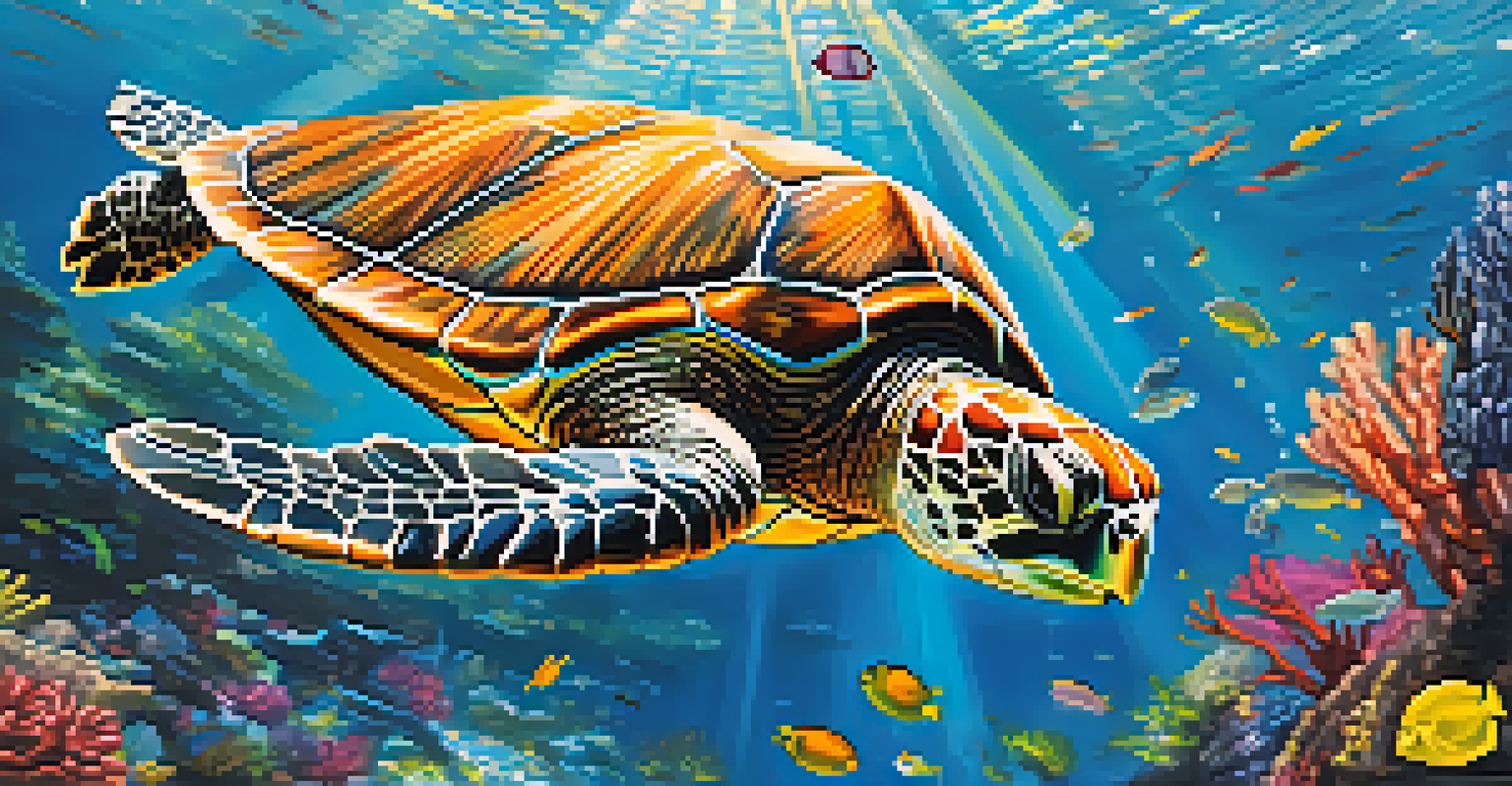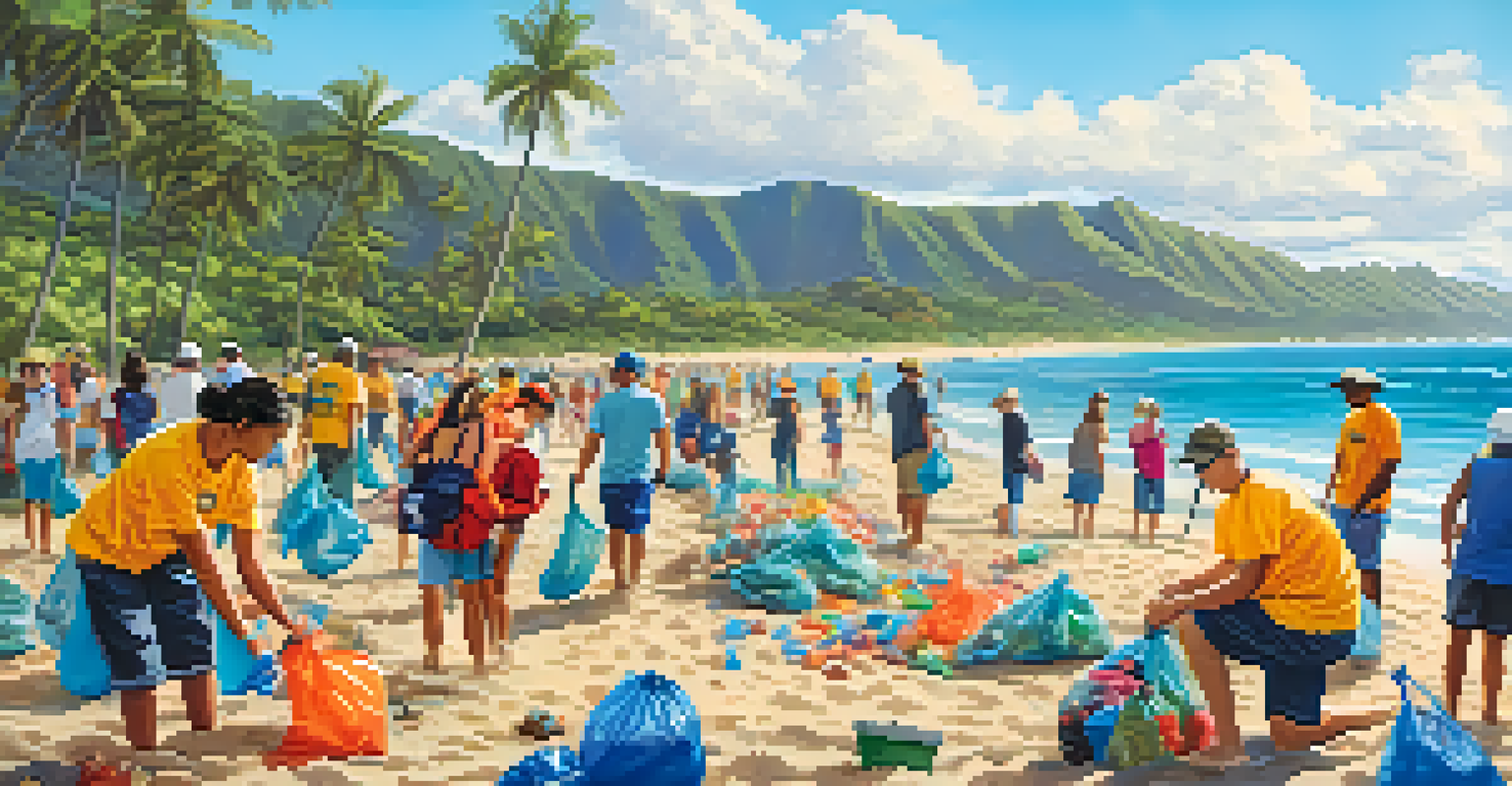The Impact of Plastic Pollution on Honolulu's Marine Life

Understanding Plastic Pollution in Honolulu's Waters
Plastic pollution has become a significant issue in Honolulu, where the beautiful beaches and vibrant marine ecosystems are under threat. Every year, tons of plastic waste end up in the ocean, harming marine life and disrupting local habitats. This pollution comes from various sources, including littering, improper waste management, and runoff from urban areas.
The greatest threat to our planet is the belief that someone else will save it.
Honolulu's unique geographical location makes it particularly vulnerable to ocean currents that carry plastic debris from distant shores. This means that even if local residents are diligent about waste disposal, they can still be impacted by pollution from faraway places. Unfortunately, plastics can take hundreds of years to decompose, leading to long-lasting environmental damage.
The consequences of plastic pollution extend beyond just aesthetics; they pose serious risks to marine species that call these waters home. From turtles mistaking plastic bags for jellyfish to seabirds ingesting small plastic pieces, the effects are dire and far-reaching.
The Direct Threats to Marine Animals
Marine animals face multiple threats due to plastic pollution, with entanglement and ingestion being the most common. Larger species, like sea turtles and whales, can become trapped in abandoned fishing gear or plastic debris, leading to injury or death. This entanglement can restrict their movement, making it difficult for them to feed or reproduce.

Ingesting plastic can be equally harmful, as many marine animals mistake plastic items for food. When they consume these materials, it can lead to internal injuries, malnutrition, or even starvation. For instance, seabirds often feed plastic to their chicks, resulting in fatal consequences for the young birds.
Plastic Pollution Threatens Marine Life
Plastic waste in Honolulu's waters harms marine species through ingestion and entanglement.
Additionally, the chemicals found in plastics can leach into the bodies of marine animals, disrupting their endocrine systems and causing long-term health issues. This bioaccumulation of toxic substances poses a significant risk not only to marine life but also to humans who consume seafood.
The Impact on Coral Reefs and Ecosystems
Honolulu's coral reefs, which are vital for marine biodiversity, are also suffering from plastic pollution. Plastics can smother corals, blocking sunlight and hindering their growth. Furthermore, the presence of plastic debris can create a breeding ground for harmful bacteria and pathogens that threaten coral health.
We won’t have a society if we destroy the environment.
Coral reefs serve as crucial habitats for countless marine species, and their decline can lead to a domino effect within the ecosystem. As coral reefs deteriorate, the fish that depend on them for shelter and food also suffer, leading to decreased fish populations and altered marine dynamics.
Moreover, the loss of coral reefs affects local communities that rely on fishing and tourism. The beauty and biodiversity of these ecosystems attract visitors to Honolulu, but as plastic pollution continues to take its toll, the economic impact grows alongside the environmental one.
Community Efforts to Combat Plastic Pollution
In response to the growing concern over plastic pollution, various community initiatives have emerged in Honolulu. Local organizations are actively engaging residents in beach cleanups, education programs, and awareness campaigns to reduce plastic waste. These efforts not only help clean the beaches but also foster a sense of responsibility among the community.
Schools and local businesses are also stepping up, implementing programs to reduce single-use plastics. For example, some restaurants have adopted eco-friendly practices, such as using biodegradable containers and encouraging customers to bring their reusable bags. These small changes can collectively make a big difference.
Community Initiatives Drive Change
Local organizations and residents are actively participating in cleanups and educational programs to combat plastic pollution.
Collaboration between government agencies, nonprofits, and community members is essential in addressing the plastic pollution crisis. By working together, they can develop effective policies, promote sustainable practices, and create a cleaner, healthier ocean for future generations.
The Role of Legislation in Reducing Plastic Waste
Legislation plays a crucial role in tackling plastic pollution in Honolulu. Local governments have begun implementing regulations that aim to minimize the use of single-use plastics, such as plastic bags and straws. These measures encourage businesses and consumers to seek alternatives that are more environmentally friendly.
For example, the City and County of Honolulu passed a law to ban plastic bags at retail establishments, pushing shoppers towards reusable options. While some businesses initially resisted these changes, many have found that eco-friendly practices can also attract environmentally-conscious customers.
As more cities and states enact similar laws, it sends a powerful message about the importance of reducing plastic waste. The ripple effect of such legislation can inspire other regions to take action, ultimately contributing to a cleaner ocean and healthier marine life.
The Importance of Individual Action in Reducing Plastic Use
While community and legislative efforts are vital, individual action is equally important in the fight against plastic pollution. Simple changes in daily habits, such as using reusable bags, bottles, and containers, can significantly reduce the amount of plastic waste generated. Every small step counts when it comes to protecting our marine ecosystems.
Additionally, individuals can support local initiatives focused on environmental conservation. Whether it's participating in a beach cleanup or advocating for sustainable practices within their communities, everyone can contribute to the cause. Spreading awareness about the impacts of plastic pollution can also inspire others to make environmentally-friendly choices.
Legislation Promotes Eco-Friendly Practices
New laws in Honolulu are reducing single-use plastics, encouraging both businesses and individuals to adopt more sustainable options.
Ultimately, collective action starts with each person recognizing their role in the larger picture. By making conscious choices and encouraging others to do the same, we can create a significant positive impact on Honolulu's marine life.
Looking Ahead: The Future of Honolulu's Marine Environment
The future of Honolulu's marine environment depends on how effectively we address the issue of plastic pollution now. If communities, governments, and individuals continue to put forth efforts to reduce plastic waste, there's hope for a healthier ocean and thriving marine life. Education and awareness will be key in driving this change.
Innovative solutions, such as advanced recycling technologies and alternative materials, can also play a role in reducing plastic production and waste. As more research emerges on sustainable practices, we can work towards creating a circular economy that minimizes plastic use and maximizes resource efficiency.

Ultimately, the journey toward a cleaner ocean is ongoing, but with increased awareness and action, we can protect the beauty and biodiversity of Honolulu's marine ecosystems for generations to come.